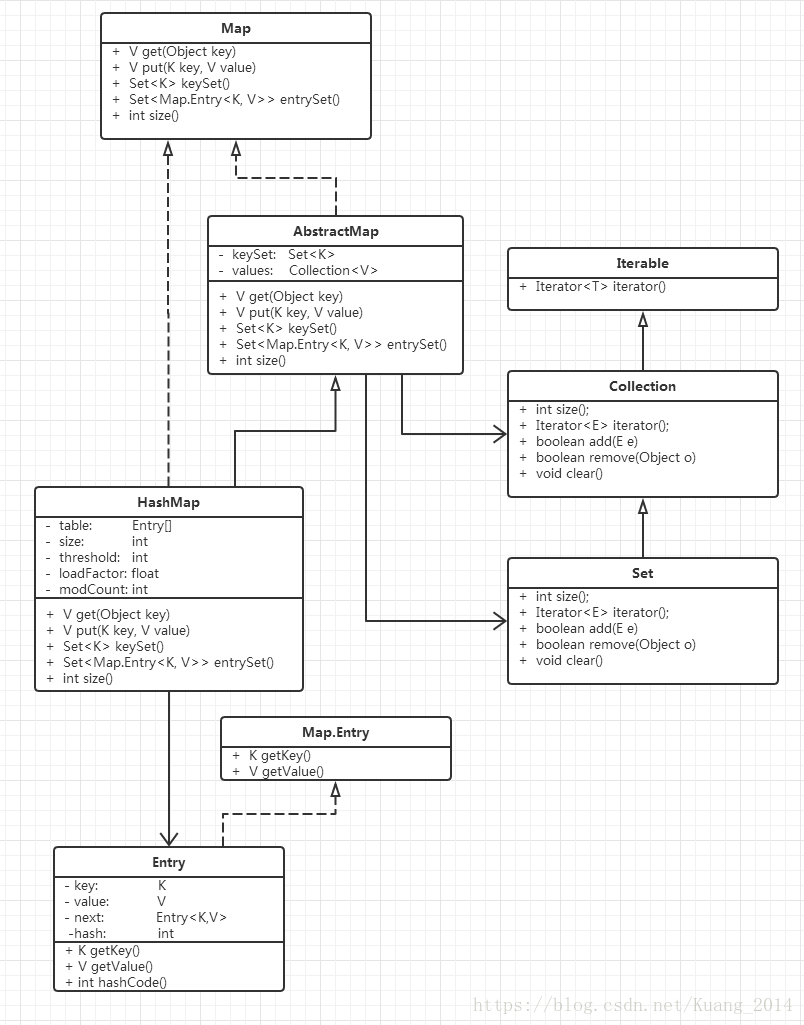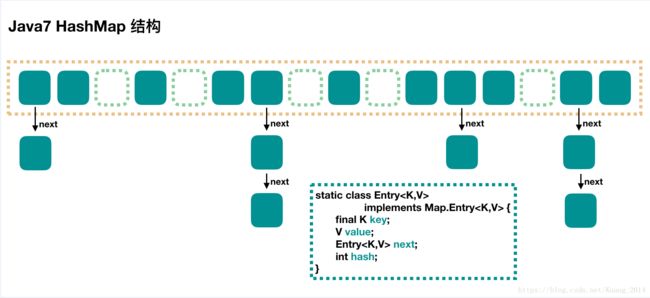Java基础-HashMap源码分析
HashMap是我们工作中经常用到的key->value键值对数据结构,但是你可曾详细了解过他的内部实现?
类图:刚复习完类图,马上温习一下,看一下HashMap的类家族
先有一个整体的结构把握,ps:这个类图已经是我第三版的杰作了,哈哈
从上图,我们能够理解,hashMap的存储结构其实就是一个entry数组,由于entry的特殊设计,entry的属性包含了一个entry,这样就让entry具有了链表的属性;
属性解释:
Entry[] table; table根据需要调整。长度必须是2的幂int size; Map中包含的键值映射的数量
int threshold; 下一个大小调整大小的值(capacity * load factor)
float loadFactor; 哈希表的加载因子。
int modCount; HashMap的结构修改次数
方法讲解:
构造方法:
public HashMap() {
this.loadFactor = 0.75f;
threshold = (int)(16 * 0.75f);
table = new Entry[16];
init();
}从构造方法里面,我们能发现初始化数组长度为16,init方法没有内容;
public V put(K key, V value);
public V put(K key, V value) {
if (key == null)
return putForNullKey(value);
int hash = hash(key.hashCode());
int i = indexFor(hash, table.length);
//这里检测如果该索引出已经有数据了,那么就遍历链表查看是否有该key的数据,如果有就覆盖返回
for (Entry e = table[i]; e != null; e = e.next) {
Object k;
if (e.hash == hash && ((k = e.key) == key || key.equals(k))) {
V oldValue = e.value;
e.value = value;
e.recordAccess(this);
return oldValue;
}
}
modCount++;
//添加数据到链表
addEntry(hash, key, value, i);
return null;
}
void addEntry(int hash, K key, V value, int bucketIndex) {
Entry e = table[bucketIndex];
//这里new一个entry,把原来值放到next属性去
table[bucketIndex] = new Entry(hash, key, value, e);
//注意threshold初始化是12,16*0.75,意思是每次容量达到索引3/4的时候会扩容
if (size++ >= threshold)
resize(2 * table.length);
}
void resize(int newCapacity) {
Entry[] oldTable = table;
int oldCapacity = oldTable.length;
if (oldCapacity == MAXIMUM_CAPACITY) {
threshold = Integer.MAX_VALUE;
return;
}
//新建一个entry数组,长度为新长度
Entry[] newTable = new Entry[newCapacity];
//复制原来的数据到新的数组
transfer(newTable);
table = newTable;
//重新设置下次扩容的条件
threshold = (int)(newCapacity * loadFactor);
}
//这里面实现很正常,稍微看一下应该能明白
void transfer(Entry[] newTable) {
Entry[] src = table;
int newCapacity = newTable.length;
for (int j = 0; j < src.length; j++) {
Entry e = src[j];
if (e != null) {
src[j] = null;
do {
Entry next = e.next;
int i = indexFor(e.hash, newCapacity);
e.next = newTable[i];
newTable[i] = e;
e = next;
} while (e != null);
}
}
}
public V get(Object key)
public V get(Object key) {
if (key == null)
return getForNullKey();
int hash = hash(key.hashCode());
for (Entry e = table[indexFor(hash, table.length)];
e != null;
e = e.next) {
Object k;
if (e.hash == hash && ((k = e.key) == key || key.equals(k)))
return e.value;
}
return null;
} public Set
下面先演示一下我们平时调用entrySet的常规用法
public static void main(String[] args) {
Map map = new HashMap();
for (int i = 0; i < 20; i++) {
map.put(i, i);
}
Iterator> it = map.entrySet().iterator();
Entry entry = null;
while (it.hasNext()) {
entry = it.next();
System.out.println(entry.getKey());
System.out.println(entry.getKey());
//删除
it.remove();
}
} 虽然平时这样用,那么你理解其中的原理吗?边看边说
public Set> entrySet() {
return entrySet0();
}
private Set> entrySet0() {
//看到这里我们应该就已经知道其实我们平时调用entrySet的时候是会保存起来
Set> es = entrySet;
return es != null ? es : (entrySet = new EntrySet());
}
private final class EntrySet extends AbstractSet> {
//这个方法是我们常用的,看他的实现,是new了一个,所以拿到iterator对象随便搞
public Iterator> iterator() {
return newEntryIterator();
}
}
Iterator> newEntryIterator() {
return new EntryIterator();
}
//注意这里是一个类
private final class EntryIterator extends HashIterator> {
public Map.Entry next() {
return nextEntry();
}
}
final Entry nextEntry() {
if (modCount != expectedModCount)
throw new ConcurrentModificationException();
Entry e = next;
if (e == null)
throw new NoSuchElementException();
if ((next = e.next) == null) {
Entry[] t = table;
while (index < t.length && (next = t[index++]) == null);
}
//知道记录这个用来干嘛吗?请看remove方法
current = e;
return e;
}
//哈哈,从这里是不是已经理解我们平时使用entryset为啥可以调用remove方法了
public void remove() {
if (current == null)
throw new IllegalStateException();
if (modCount != expectedModCount)
throw new ConcurrentModificationException();
Object k = current.key;
current = null;
HashMap.this.removeEntryForKey(k);
expectedModCount = modCount;
} 看完entrySet再来看keySet,你会恍然大悟,其实keySet就是调用了entrySet的方法,只是next方法被重写了,所以计算量还是达到了entrySet这么多,怎么样,不相信吧,自己去看一下。
看完hashMap,再把Set和List看完,之后再来研究一下ConcurrentHashMap。

